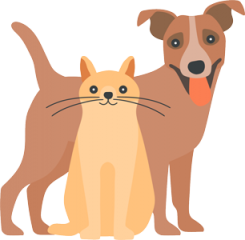Pet care
Being a responsible pet owner is about more than just socialising and feeding your furry (or feathered) friend. Switching to plastic-free pet options is a great next step in your plastic-free journey.

What can you do
Choosing plastic free toys, treats, and bulk pet food are popular ways to reduce plastic exposure and your pet’s plastic pawprint.
How can you do it
Pets love to chew, so the risks around toxicity, choking and digestive issues are important considerations when you choose their toys. Dogs and cats can shred plastic toys in a matter of minutes creating swallowable plastic fragments that may lead to a very expensive vet visit. Many people have found switching to durable, eco-friendly toys saves time and money. Consider toys made from wood, rope, hemp, and other sustainable materials.
There are alternatives to pet food wrapped in plastic packaging. Popular choices include recyclable tins, bulk dry food, or asking your local butcher or fishmonger if you can bring your own container to stock up on meat, bones, or fish. Some people purchase unwrapped treats or refill dry food containers at pet bulk produce stores or markets.
Did you know one of the most-asked questions at Plastic Free July is how to reduce plastic use when dealing with dog poo? At home, you can swap your single-use plastic bag for a shovel or pooper-scooper and pop it straight in the bin. Some people have also created a compost system for pet waste in their yard (this should not be used on any food-generating plants). When out and about, consider using tongs or pooper scoopers to pick up and reusable containers to carry to the nearest bin. Compostable poo bags are a single-use option when reusable options are not available.
Taking the next steps
Pets aren’t fussy about what they play with as long as you’re involved. Some people make their own toys such as a simple tug rope from natural fibre offcuts or an old t-shirt. While we are all for reusing, we recommend you avoid giving your pets old shoes. Dogs don’t know the difference between a holey sneaker and your expensive leather boots.
Some people avoid plastic by making their own pet food. You can often bulk up pet meals with leftover pasta and vegetables. It’s always a good idea to check you are meeting your pet’s nutritional requirements by consulting a vet first.
Consider natural fibres for pet bedding such as jute, hessian, or wool, and sustainable food bowl options including ceramic, stainless steel, or bamboo.
Beauty bars aren’t just for humans. Another simple switch is pet shampoo bars.
The impact
- If you feel as though you spend a lot of time cleaning up after your pet, you’re right. One dog will poo around 14,500 times over its lifetime. Opting for a plastic-free alternative when collecting pet waste saves the equivalent number of single-use plastic bags from landfill.
- Our furry friends are a marketer’s dream with fancy-dress costumes, plush toys, individually wrapped treats and even IQ puzzles some of the many plastic-based pet items now available. Reducing your pet’s plastic pawprint helps to protect the environment for all animals.
- Avoiding plastic when it comes to our pets is another step towards making choices that benefit all animals from majestic whales to the human species. The human health impacts of plastic including microplastics in humans are becoming increasingly clear. If you’re interested in finding out more, Professor Sarah Dunlop from our principal partner, the Minderoo Foundation offers her expert advice.


